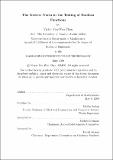The Gowers norm in the testing of Boolean functions
Author(s)
Chen, Victor Yen-Wen
DownloadFull printable version (305.5Kb)
Other Contributors
Massachusetts Institute of Technology. Dept. of Mathematics.
Advisor
Madhu Sudan.
Terms of use
Metadata
Show full item recordAbstract
A property tester is a fast, randomized algorithm that reads only a few entries of the input, and based on the values of these entries, it distinguishes whether the input has a certain property or is "different" from any input having this property. Furthermore, we say that a property tester has completeness c and soundness s if it accepts all inputs having the property with probability at least c and accepts "different" inputs with probability at most s + o(1). In this thesis we present two property testers for boolean functions on the boolean cube f0; 1gn. We summarize our contribution as follows. We present a new dictatorship test that determines whether the function is a dictator (of the form f(x) = xi for some coordinate i), or a function that is an "anti-dictator." Our test is "adaptive," makes q queries, has completeness 1, and soundness O(q3) 2??q. Previously, a dictatorship test that has soundness (q + 1) . 2-q is achieved by Samorodnitsky and Trevisan, but their test has completeness strictly less than 1. Furthermore, the previously best known dictatorship test from the PCP literature with completeness 1 has soundness ... . Our contribution lies in achieving perfect completeness and low sound- ness simultaneously. We consider properties of functions that are invariant under linear transformations of the boolean cube. Previous works, such as linearity testing and low-degree testing, have focused on linear properties. (cont.) The one exception is a test due to Green for "triangle freeness": a function f satisfies this property if f(x); f(y); f(x + y) do not all equal 1, for any pair x; y 2 f0; 1gn. We extend this test to a more systematic study and consider non-linear properties that are described by a single forbidden pattern. Specifically, let M denote an r by k matrix over f0; 1g. We say that a function f is M-free if there are no ~x = (x1,...,xk), where x1,...,xk 2 f0; 1gn such that f(x1),...,f(xk) = 1 and M~x = ~0. If M can be represented by an underlying graph, we can analyze a test that determines whether a function is M-free or \far" from one. Our test makes k queries, has completeness 1, and soundness bounded away from 1. The technique from our work leads to alternate proofs that some previously studied linear properties are testable, albeit with worse parameters. Our results, though quite different in terms of context, are connected by similar techniques. Our analysis of the algorithms relies on the machinery of the Gowers uniformity norm, a recent and powerful tool in additive combinatorics.
Description
Thesis (Ph. D.)--Massachusetts Institute of Technology, Dept. of Mathematics, 2009. This electronic version was submitted by the student author. The certified thesis is available in the Institute Archives and Special Collections. Includes bibliographical references (p. 65-68).
Date issued
2009Department
Massachusetts Institute of Technology. Department of MathematicsPublisher
Massachusetts Institute of Technology
Keywords
Mathematics.